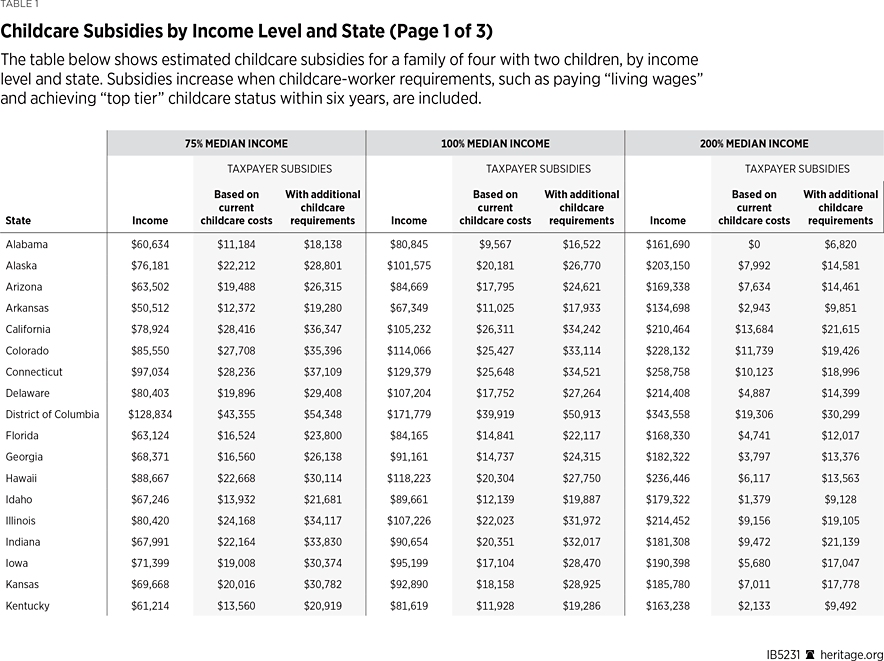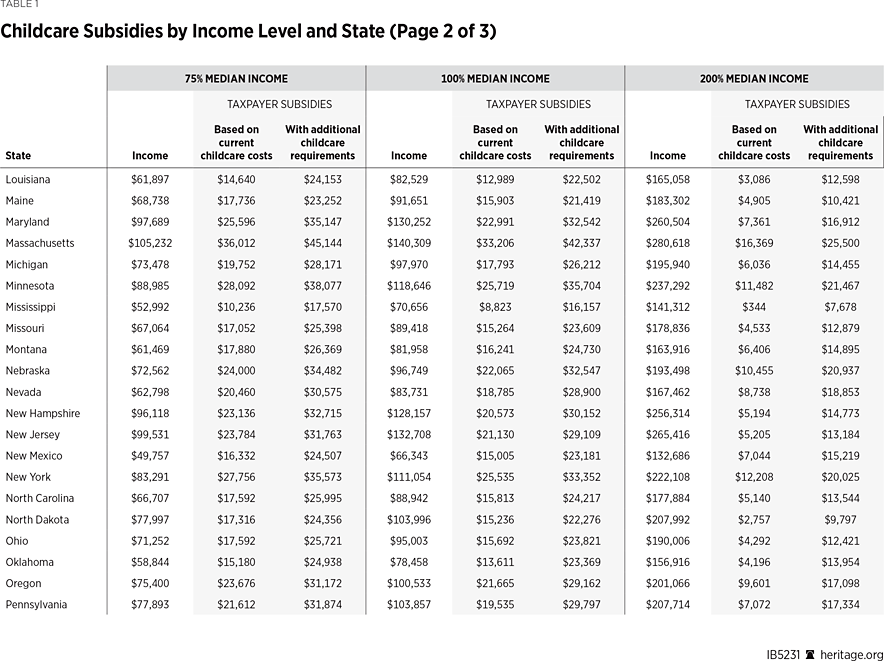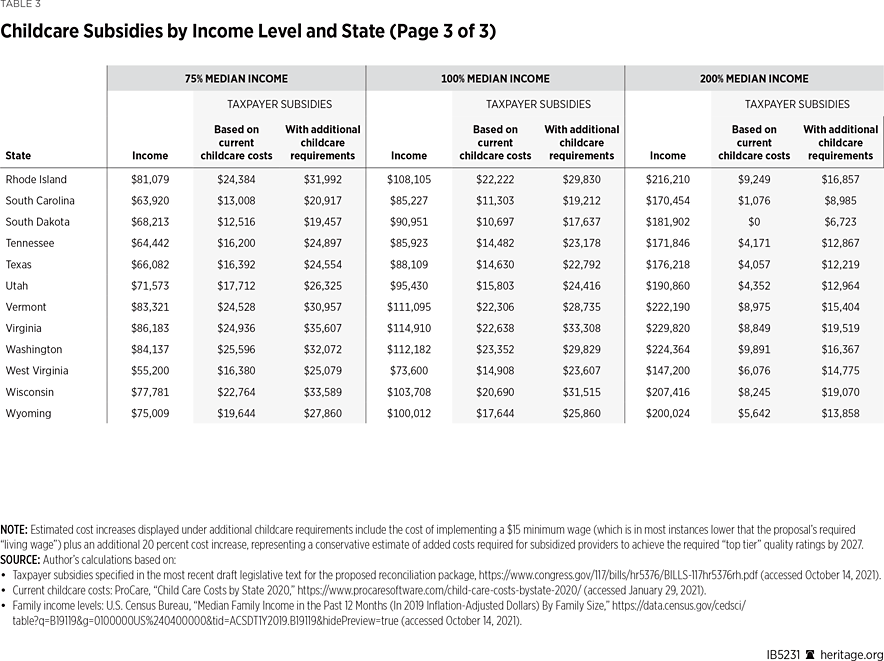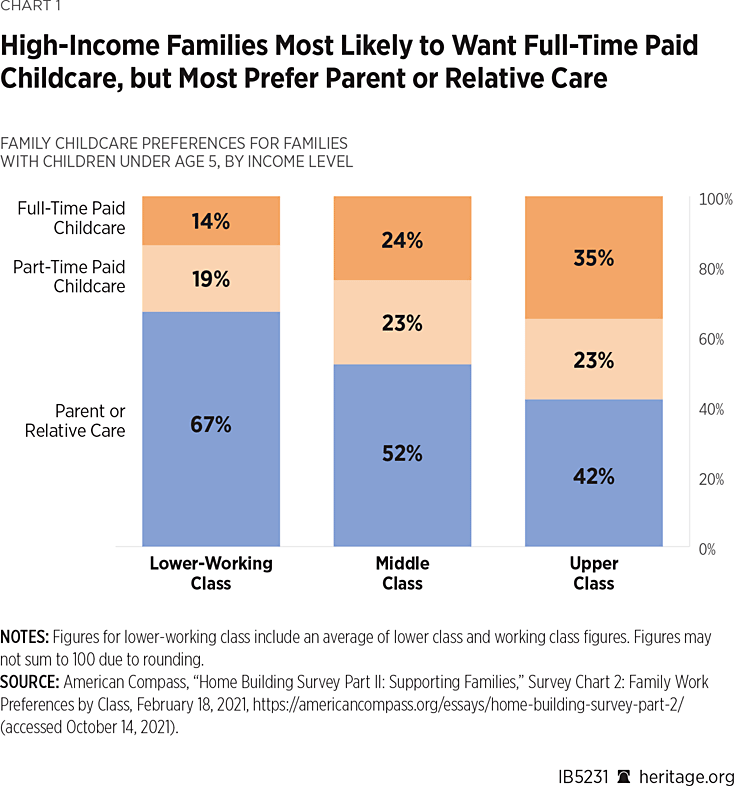Liberal lawmakers want to create a new federal entitlement for childcare subsidies, guaranteeing all children access to “top-tier” childcare at a cost of no more than 7 percent of their parents’ income. Finding the type of childcare that families want at a cost they can afford can be difficult, especially for lower-income and single-parent families. Federal policies could do a far better job of helping families in need, but is the proposed new federal entitlement the right solution? This Issue Brief examines childcare subsidies by income level, family type, and state to see whom would benefit most, and then considers the implications of a large new federal entitlement on the costs and availability of childcare that parents want.
Summary of Childcare Proposal
The $3.5 trillion reconciliation package includes the Birth Through Five Child Care and Early Learning Entitlement Act, which would provide federal grants to states that the states then distribute to licensed childcare providers that participate in the states’ newly required tiered quality-rating systems, and that meet existing and new state health and safety rules. Parents of all income levels would be eligible to receive subsidies if they are participating in an eligible activity,REF provided their assets do not exceed $1 million, and so long as their childcare costs exceed federally established limits, based on state of residence, income level, and family size. Based on a sliding scale, parents making 75 percent or less of their state’s median income would pay nothing for childcare, parents making 100 percent of their state’s median income would pay no more than 2 percent of their income for childcare, and parents making 150 percent or more of their state’s median income would pay no more than 7 percent of their income for childcare.
In order for childcare providers to qualify for the subsidies, they would have to submit to continual government-reporting requirements, follow newly established federal requirements, such as providing a “living wage” that, at a minimum, equals the pay rates of public school educators with similar credentials, and meet increasing federal standards on a pathway to becoming “top tier”–certified providers. Although not specifically listed, such requirements could include reducing child-to-staff ratios, employing childcare workers with education similar to that of kindergarten teachers, transforming interior and exterior childcare spaces, and complying with new green energy standards. Moreover, the legislation stipulates that providers—including religious organizations—that receive subsidies will be considered recipients of federal funds, which could limit their ability to run their programs and hire childcare workers in accordance with their religious beliefs.
Federal funding for the program is set at $20 billion for fiscal year (FY) 2022, $30 billion for FY 2023, and $40 billion for FY 2024. Funding for FY 2025 through FY 2027 is equal to such sums as necessary to cover 90 percent of states’ costs to cover the “policies and financing practices that will ensure all families of eligible children can choose for the children to attend child care at the highest quality tier within 6 years after the date of enactment of this Act.”REF Beginning in 2025, the proposal requires that states provide a childcare entitlement to every eligible family, though no consequences for failure to do so are listed. No funding is specified beyond FY 2027, and thus it is assumed that the program would require a future Congress to pass legislation to fund the program beyond that time.
Current Childcare Costs and Access
In 2018, the average cost for center-based childcare was $10,451 per child, while the average cost for in-home care was $8,331 per child.REF While the total number of childcare providers has remained relatively stable in recent decades, there has been a shift away from small family-based providers toward large center-based providers. Between 2005 and 2017, the number of small in-home providers fell by 52 percent (a loss of 92,400 providers).REF In large part, this is the result of burdensome and arguably ineffective childcare regulations that can make it extremely difficult and costly for individuals to run family-based childcare programs.
A study of Illinois’ licensed in-home providers found that in addition to providing 51 hours per week of paid childcare, they spent another 18 hours performing unpaid administrative work.REF Added requirements to become a subsidized provider and to achieve “top tier” childcare standards within six years would undoubtedly add to childcare providers’ administrative burdens.
Proposal Would Increase Costs, Crowd Out Private Childcare Providers
The requirement that providers pay a “living wage”—a metric that is not clearly defined—and, at a minimum, must equal the pay rates of elementary school educators with similar credentials, would drastically increase childcare costs. This author estimated that increasing the minimum wage for childcare workers to $15 per hour would raise childcare costs by 22 percent, on average, across the U.S.REF A “living wage” is meant to represent the minimum earnings necessary for a family of a given size and living in a given geographic area to meet its basic needs while remaining self-sufficient. In nearly all instances, a “living wage” is significantly higher than $15 per hour.



According to the Massachusetts Institute of Technology’s living-wage calculator, the living wage for a single mother with one child who lives in Boston is $39.08 per hour, while the living wage for a single mother with one child living in Jackson, Mississippi, is $27.40.REF The legislation also says that wages must be at least equal to the wages of public elementary educators with similar credentials and experience. The current average public school teacher salary of $63,645 comes out to $30.60 per hour.REF A rough estimate for the impact of a “living wage” requirement among subsidized childcare providers is that it would increase costs by 50 percent to 75 percent, depending on state and federal interpretations of a living wage.REF This is only one of potentially many costly new requirements that providers receiving subsidies would have to implement.
It appears that a goal of the childcare subsidies is to extend public education not only to pre-K, but to ages zero through three as well. The average cost of public K–12 education across the U.S. is $14,400 per pupil, including 180 days per year with 6.5 hours per day and 15-to-1 teacher-student ratios.REF Childcare centers would presumably be open 250 days per year, 10 hours per day, and average four-to-one or five-to-one teacher-student ratios.REF Providing a similar product with at least three times as many teachers and nearly twice as many hours per year could easily result in childcare costs equaling twice the current per-pupil cost of public K–12 education.
Some of the requirements may be difficult or impossible to fulfill. For example, most religious providers will be unwilling to become recipients of federal funds that could restrict their ability to run their organizations and hire staff according to their beliefs. Those same religious providers may not have necessary physical space—or the congregation may be unwilling to transform the worship spaces—to meet new standards. And, smaller family providers may not be able to obtain the permits required to alter their homes or outside spaces. Moreover, if achieving “top tier” childcare status requires childcare directors to obtain an associate’s or bachelor’s degree, many mothers and grandmothers who provide in-home childcare would not qualify for subsidies. Yet, in-home childcare programs currently make up the majority of licensed providers in more than 20 states.
In addition to the burden of new federal requirements, uncertainty about funding beyond FY 2027 could prevent many providers—especially smaller in-home and religious providers—from seeking to become subsidized providers. That could lead to a two-tiered network of public and private childcare providers, with families having to choose between highly subsidized public childcare centers and a more diverse network of non-subsidized, private childcare providers.
In Chicago, the roll-out of universal pre-K is “strangling private day care of 3- to 5-year-olds,” as costs become parents’ determining factor in choosing preschool programs, even if the government’s program does not meet their needs.REF Weakening the payment link between families and childcare providers would not only lead to childcare centers basing their programs on government bureaucrats’ desires over families’ desires, but the transmission of funds from federal policymakers to states to childcare providers will inevitably lead to waste, abuse, and inefficiency. Preschool providers that have experienced New Jersey’s supposedly model preschool program say that it has not been implemented as designed. They say the program has an accountability crisis, is fraught with political favoritism, and has resulted in subsidized providers losing their contracts or having their budgets reduced without explanation.REF
Proposed Childcare Subsidies by Income Level and State
Table 1 provides estimated taxpayer subsidies that would be available to parents who want to use, and are able to find, government-subsidized childcare providers. As shown, subsidy amounts vary based on families’ income levels, the number of children in childcare, and families’ states of residence.REF Two subsidy levels are provided: The first shows subsidies based on current childcare costs; the second provides a more realistic estimate of subsidies, taking into account the likely childcare cost increases that would result from requirements, such as paying childcare workers “living wages,” and for subsidized childcare providers to achieve “top tier” childcare status within six years.REF
Contrary to the presumed goal of helping lower-income and working-class families, it appears that childcare subsidies would be heavily skewed toward high-income families. For example, a couple making $343,600 in Washington, DC, would receive $30,300 in childcare subsidies for two children, while a couple making $53,000 in Mississippi would receive $17,600 in childcare subsidies for two children. Though not listed in the table, subsidies would be zero for families that choose to have a parent stay home with the children, and zero for families that either do not choose, or are unable to find, a government-approved subsidized childcare provider.
Families Preferences for Childcare
Parents have diverse preferences for childcare, but most prefer family care. According to a recent survey by American Compass, 57 percent of parents prefer that their children receive care from a parent or relative, while 22 percent prefer that children attend full-time paid childcare.REF Preferences vary significantly across income groups, however. Among lower-class and working-class families, 67 percent prefer family care and only 14 percent prefer full-time paid childcare. Among upper-class families, 42 percent prefer family care and 35 percent prefer full-time paid childcare. In no small part, families’ childcare preferences are a determining factor in their incomes, as some parents’ decisions to give up time in the paid workforce to care for their children results in lower family incomes.

Families’ preferences and who would benefit from subsidies are important factors in evaluating the proposed childcare subsidies because center-based childcare would dominate the subsidized childcare market. Relatives who provide childcare would not be eligible for childcare subsidies, and the requirements to become subsidized childcare providers would be harder for smaller, in-home, and faith-based providers to achieve. Consequently, taxpayer subsidies may shift more resources to affluent families and advantaged children than to lower-income families or disadvantaged children.
By tilting the scales away from family care and faith-based care and toward center-based childcare, subsidies could shift children into settings that are not their parent’s preferences. The potential adverse effects of such shifts are evident in subsidized childcare programs in Quebec,REF the U.S.,REF and elsewhere.REF Perhaps most notable, however, are words of caution that come from one of the most widely cited experts on the benefits of early childhood education programs, James Heckman: “No public preschool program can provide the environments and the parental love and care of a functioning family and the lifetime benefits that ensue.”REF
In noting his studies’ findings of returns as high as 13 percent from small-scale and intensive early childhood programs, Heckman said that those benefits likely pale in comparison to the returns from loving family care: “I’m willing to bet that if we really evaluated what the benefits were of a mother working with the child, we’d find rates of return of more like 30 or 40%. But nobody has ever studied it.”REF
What has been shown, however, is that large childcare subsidies cause mothers to spend more time working and less time with their children.REF The push to get more children into full-time center-based childcare comes at a particularly bad time, as a surge in flexible jobs and family-friendly workplace policies has allowed parents to spend more time with their children. And individual innovators—as opposed to politicians and bureaucrats—are already helping to expand options for families. For example, MyVillage is an online company started by two moms who wanted to expand in-home childcare by helping potential providers—mostly moms—to navigate the licensing system and business management aspects so that they can provide nurturing childcare in their homes.REF Other platforms, such as Wana Family Network and Komae, provide a way for parents to achieve zero-cost childcare by setting up co-ops where parents care for one another’s children.REF Large government subsidies would tip the scales away from these flexible options that many parents prefer.
Conclusion
How to care for their children is one of the most important decisions that parents make, and helping to ensure that families can pursue the childcare environments that work best for them should be a priority for policymakers. Providing massive federal subsidies only to families that choose to follow the ideals of certain politicians—for all parents to work full-time and send their children to government-approved childcare—could fundamentally alter childcare in the United States. Instead of focusing on lower-income families in need, the proposed subsidies would disproportionately benefit high-income families in high-cost states. These subsidies would do nothing to help the majority of families that prefer family-based childcare, and could limit options by crowding out smaller, faith-based, and more accommodating childcare providers. Moreover, incentivizing parents to shift kids out of family care and into center-based childcare could have lasting consequences for children and families.
Instead of massive subsidies for one type of government-approved childcare that does not reflect most families’ desires, policymakers should expand options within existing government childcare programs by allowing families to use federal childcare subsidies and Head Start funds at a provider of their choice. Moreover, by reducing unhelpful and burdensome childcare regulations (as opposed to heaping on new regulations tied to federal subsidies), policymakers can help to increase the supply of flexible and affordable options that better meet families’ wants and needs.
Rachel Greszler is Research Fellow in Economics, the Budget, and Entitlements in the Grover M. Hermann Center for the Federal Budget, of the Institute for Economic Freedom, at The Heritage Foundation.



